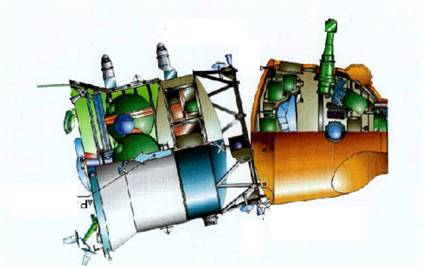Explosive bolts that help detach the Russian Soyuz capsule from the International Space Station may be the source of the problems the spacecraft has encountered during the last two landings. Investigative space journalist and Jim Oberg at MSNBC, who is one of the best experts on the inner workings of the Russian space program recently wrote a very interesting article detailing Russian engineers’ plans to fix the problem: have two Russian cosmonauts conduct a spacewalk on July 10 to remove one of the explosive bolts and bring it inside the space station. The bolts, Oberg says, packs twice the explosive force of an M-80 firecracker when ignited, and the cosmonauts will be handling the bolts directly during what will be a very delicate, if not dramatic, operation.
Oberg reports that Russian space engineers say the bolts at one particular location failed to work properly during each of the two previous Soyuz landings, in October 2007 and then in April 2008. As a result, in each case the landing capsule was twisted out of proper orientation and underwent excess heating on unshielded surfaces before tearing loose from the propulsion module and falling to Earth.
NASA has scheduled a press briefing on July 8 to discuss the spacewalk, but Oberg uncovered details about the spacewalk from status reports and discussions with NASA engineers. The engineers in Houston said that, to their knowledge, no such pyrotechnic device has ever been brought into the space station in its 10-year history.
There are five pairs of explosive bolts that break the connections between the spacecraft’s crew capsule and its propulsion module during descent. Russian experts told NASA at one particular location, position 5, apparently failed to fire during both previous Soyuz descents, preventing a clean separation.
The two cosmonauts, station commander Sergey Volkov and flight engineer Oleg Konenenko will remove the position 5 bolt and place it in a shielded safety canister that was brought to the ISS on the last shuttle mission in May for this spacewalk. So obviously, the plan for this spacewalk has been in the works for quite some time.
Russians engineers assured NASA that the remaining four latches will be adequate to hold the two modules together during any other maneuvers in space.
Check out Jim’s article for more details.


OK, The bolts secure the Soyuz to ISS but the graphic posted with the story shows the bolt holding the capsule to it’s propulsion module. It appears the references to the connection between Soyuz and ISS should be revised or deleted.
Ayti-
You are right, and I was wrong. Info in the article has been corrected.
Thanks.
Why does this sound like a really bad idea?
Its tricky enough to remove a piece of explosive from a spaceship (in space, no less) but to bring the device aboard, with changes in temperature and god knows what else making it less stable….
the risk to life and risk to the station….
What are they looking for that cant be researched on the ground?
After reading James Oberg’s article at the MSNBC site, the bolts to be checked are clearly denoted as those between the Soyuz crew module ant the propulsion module, not the Soyuz and the ISS. I suggest Ayti & Atkinson carefully read this article give readers correct info. The supplied diagram is in fact correct. From earlier reports this crew-propulsion module separation was the source of the problem. These two pieces of equipment separate only after Soyuz undocks from the ISS and maneuvers itself in preparation for re-entry. I do agree with Maxwell, this procedure sounds exceedingly risky( one only need remember problems with ‘flaming oxygen cannisters’ from previous missions).
Jon Hanford
You’d do well to carefully read all of my post above and find that I was in fact pointing out the exact discrepancy you are. Ms Atkinson was acknowledging the error.
I think they’ll handle it with the care and caution necessary, and everything will turn out fine.
I’m sure they’ll be cautious.
My question would be if this is a worth while risk for what seems to be something that could be tested on the surface.
Unless I’ve misread something, Why not just pop a bolt off a Soyuz on the assembly line then stick it in an oven or vacuum chamber to sort out whats wrong?
Normally stories about malfunctioning explosive devices end with “we blew it up in the parking lot, just to be safe”.
Not “we brought it inside the house to study”.
My favorite part of the story is that it was released just in time for Independence Day in the US. For those outside the US: we typically celebrate the holiday by blowing things up with small explosives (like the M-80 mentioned). Favorite items to blow up here in Texas: empty beer cans, fire ant mounds, and sometimes, unfortunately, our own fingers. Fortunately, Mission Control (in Houston, of course) can probably find some local three-fingered consultants in case there are any questions.